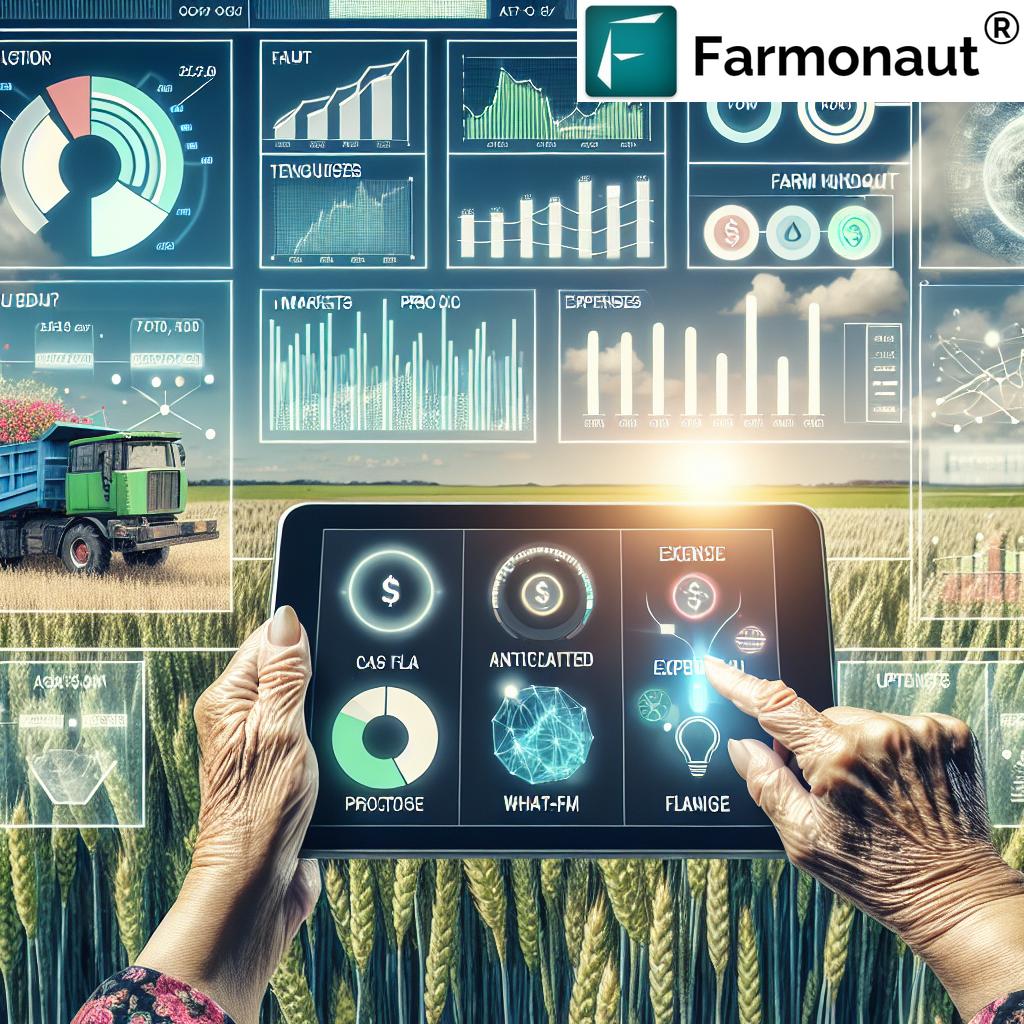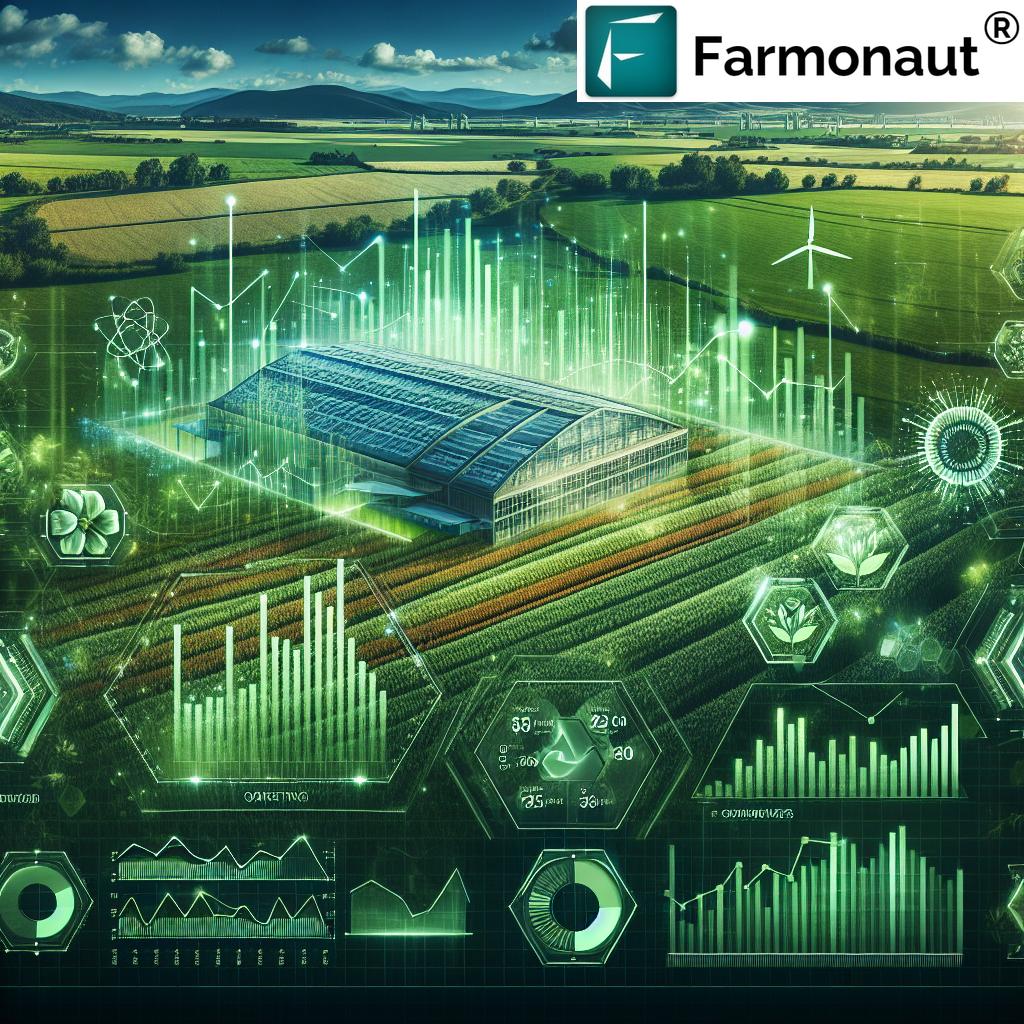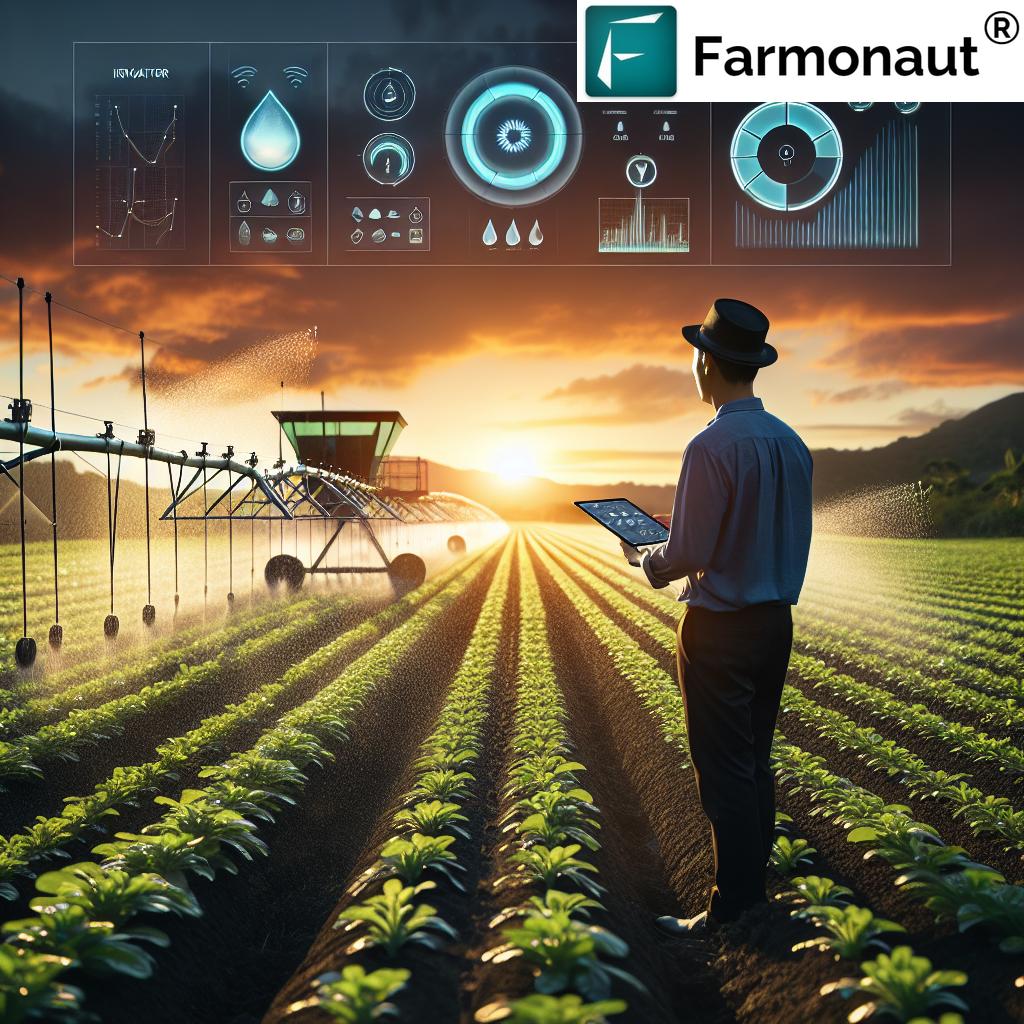Farming 5.0: Revolutionizing Agriculture with AI, IoT, and Machine Learning
“Farming 5.0 leverages over 75% data-driven decisions in crop management using AI and machine learning by 2025.”
Table of Contents
- What is Farming 5.0?
- The Evolution: From Farming 4.0 to Farming 5.0
- Key Pillars: AI, IoT, and Machine Learning in Agriculture 5.0
- Precision, Sustainability, and Resilience in Modern Farming
- Impact on Productivity and Food Security
- Farmonaut: Satellite-Driven Solutions in Agriculture 5.0
- Technology Comparison Table: AI vs IoT vs ML
- Environmental and Economic Benefits
- Access, Affordability & Inclusion: Democratizing Innovation
- Challenges & The Road to 2025 and Beyond
- Frequently Asked Questions
- Conclusion: The Future of Agriculture with Farming 5.0
What is Farming 5.0?
Farming 5.0, also referred to as agriculture 5.0 artificial intelligence IoT and machine learning, represents the next milestone in global agriculture. Building on the innovation of Farming 4.0, Farming 5.0 moves beyond just data-driven automation towards cognitive, intelligent, and adaptive farming ecosystems. This shift is propelled by the seamless integration of artificial intelligence (AI), the internet of things (IoT), and machine learning (ML), turning everyday agricultural activities into interconnected, autonomous, and highly optimized systems by 2025.
The farming sector stands on the cusp of profound change: As global population growth, climate variability, and demands for sustainable food intensify, new approaches are required to maximize crop productivity, ensure environmental sustainability, and secure food chains. The move to farming 5, enabled by AI, IoT, and ML, marks the dawn of true precision, efficiency, and resilience in agriculture.
The Evolution: From Farming 4.0 to Farming 5.0
To fully appreciate the leap that farming 5.0 represents, it is essential to understand its origins in farming 4.0—the era that introduced digitalization, automation, and data-centric approaches into everyday farming activities.
- Farming 4.0 laid the groundwork by incorporating technologies like sensors, GPS-guided machinery, drones, and basic data analytics, improving efficiency and reducing resource waste.
- Farming 5.0 takes these digital foundations further by embedding truly intelligent, self-optimizing systems into farms, enabling continuous learning, autonomous action, and holistic oversight of the entire agricultural ecosystem.
This shift marks a move from just “smart farming” (guided by human interpretation of data) towards “cognitive farming”, where the AI-enabled ecosystem itself can collect, analyze, predict, and autonomously act on vast data streams across weather, soil, crops, and more.
What Defines Agriculture 5.0 Artificial Intelligence IoT and Machine Learning?
- Hyper-connected Ecosystems: All key farm components—soil, machinery, crops, livestock—are monitored and managed via interconnected, IoT-powered systems.
- Adaptive, Data-driven Intelligence: AI and ML process historical and real-time data, learning continuously to make predictive and prescriptive recommendations—minimizing human intervention for most routine tasks.
- Automation & Autonomy: From irrigation to pest control to yield forecasting, intelligent automation acts on fast, accurate data, resulting in resource-efficient, climate-resilient, and sustainable practices.
Key Pillars: AI, IoT, and Machine Learning in Agriculture 5.0
At the heart of farming 5.0 stands the synthesis of AI, IoT, and ML—each technology playing a distinct yet overlapping role in revolutionizing agricultural practices, sustainability, and productivity.
Artificial Intelligence (AI) – The Brain of Modern Agriculture
AI enables the analysis and synthesis of vast data streams, allowing farms to become intelligent and self-optimizing ecosystems. With AI:
- Crop Recommendations: AI algorithms predict the best crops and varieties for each plot by analyzing soil health, environmental trends, and market demand.
- Pest and Disease Forecasting: Early prediction of pest infestations or disease outbreaks helps minimize crop loss through targeted action.
- Precision Irrigation: By pairing weather, moisture, and crop-stage data, AI optimizes irrigation scheduling, reduces water waste, and improves yield.
- Resource Optimization: AI-optimized fertilizer and pesticide use enhances productivity while reducing environmental impact.
A notable tool, like Jeevn AI Advisory System available via Farmonaut, delivers these capabilities by processing satellite-derived insights and forecasting actionable guidance in real-time.
The Internet of Things (IoT) – The Nervous System of the Future Farm
- Sensors Everywhere: Soil moisture sensors, weather stations, and drones collect and share data continuously, ensuring accurate, real-time monitoring of every variable that influences crop health and yield.
- Automation of Physical Systems: IoT devices trigger automated irrigation, fertilization, and pest management at the precise time and location needed.
- Livestock Monitoring: Wearable sensors on animals track health, well-being, and productivity, enabling preventative care and reducing losses.
- Operational Efficiency: Connected machinery and fleets optimize logistics and maintenance, reducing fuel use and improving ROI.
Machine Learning (ML) – The Engine of Continuous Adaptation
Machine learning models continuously improve task predictions by learning from new and historical data. What does this mean in action for farming?
- Adaptive Pest Management: Models detect small shifts in crop health patterns and automatically adjust pest management protocols—reducing chemical use and improving outcomes.
- Yield Forecasting: By integrating weather, soil, satellite, and operational data, ML can accurately forecast yield outcomes, supporting better planning and market strategy.
- Personalized Management: Each plot or zone within a field receives tailored recommendations—fertilizer, irrigation, plant density—raising efficiency.
“By 2025, over 60% of global farms are projected to use IoT-integrated systems for precision agriculture in Farming 5.0.”
Precision, Sustainability, and Resilience in Modern Farming
Farming 5.0 emphasizes an approach built around precision, sustainability, and resilience in the face of global climate change.
Precision Agriculture: Minimizing Waste, Maximizing Yield
- Every resource is measured: Fertilizers, water, and pesticides are applied only where, when, and in the quantity required—improving efficiency and reducing costs.
- Automated machinery: Operate at precisely mapped routes based on real-time field conditions, reducing fuel consumption and human error.
- Smart irrigation: IoT soil moisture sensors, linked to AI analytics, trigger watering systems at optimal intervals, resulting in significant water conservation.
Farmonaut’s Large Scale Farm Management tools deliver satellite-based oversight, allowing agricultural enterprises and land-owners to monitor environmental impact, crop health, and resource use on a scalable, cost-effective basis.
Sustainability Through Environmental Stewardship
- Reduced pollution: Targeted application of inputs (fertilizers, pesticides) decreases runoff, helping to preserve soil and water quality.
- Carbon footprint monitoring: Farms can now track emissions impact in real time, promoting climate-smart, regenerative practices and regulatory compliance.
- Resilience to extreme weather: Predictive analytics help farmers adapt operations in advance of droughts, floods, or abnormal heat spells—preserving yield and supporting food security.
In this context, Farmonaut’s Carbon Footprinting tools support users in quantifying and reducing their environmental impact, enabling progress towards net-zero emissions.
Resilience to Change: Adaptive, Data-Driven Decision Making
By 2025, the true power of farming 5 is realized as adaptive models continuously update and respond to ever-changing global conditions, allowing farms to stay ahead of trends such as changing market demand, climatic volatility, or new regulatory landscapes.
- Real-time alerts and insights: Allow earlier action against threats like pest infestations or drought, supporting continuity of food production.
- Diversification and planning: AI can recommend crop rotations or new practices to preserve soil health, expand biodiversity, and cushion economic risk.
Impact on Productivity and Food Security
With AI, IoT, and ML at its core, agriculture 5.0 artificial intelligence iot and machine learning is revolutionizing food systems by:
- Raising productivity: Data-driven, precision farming approaches target every limiting factor in yield, from soil health to weather risk to automated irrigation.
- Reducing losses: AI-powered predictive maintenance on machinery leads to fewer breakdowns; early detection of crop threats reduces waste.
- Ensuring supply chain resilience: Blockchain-based traceability ensures food can be tracked from farm to fork, improving quality control and market access.
Farmonaut API – Expand Your Capabilities
Unlock the next level of satellite-based insights for farming, resource, and environmental management with the Farmonaut API.
- Integrate seamless monitoring and analytics into your existing software or operations.
- Suitable for developers, agritech businesses, and researchers.
- API Developer Documentation
Farmonaut: Satellite-Driven Solutions in Agriculture 5.0
As pioneers in satellite technology, we at Farmonaut have witnessed first-hand how integrating satellite imagery with AI, ML, and IoT can transform decision-making across farming, crop health monitoring, and resource management. Our mission is to ensure these valuable insights are accessible and affordable for farms, businesses, and governments globally.
- Satellite-Based Monitoring: Our app and platform analyze multispectral satellite data, offering clarity on NDVI (vegetation health), soil moisture, and emerging crop threats. This continuous monitoring empowers better yield prediction and resource optimization.
- AI-Advisory (Jeevn AI): Through AI and weather pairing, we provide real-time, actionable recommendations—be it for choosing optimal planting dates, forecasting pest outbreaks, or responding to environmental risks.
- Blockchain Traceability: Through traceability, we support supply chain transparency, reducing fraud and building trust between producers and end-consumers.
- Environmental Impact Monitoring: With carbon footprint tracking, we assist users in embracing more sustainable, responsible farming practices for a future-proofed business model.
- Fleet and Resource Management: Our fleet management system ensures that agricultural fleets and equipment operate efficiently, cutting operational costs and enhancing safety.
- Access to Financing: By enabling satellite-based verification for crop loans and insurance, we assist financial institutions in providing better access and safeguarding both lenders and borrowers from risk. Learn more about our crop loan and insurance solutions.
Our mission is to democratize access to cognitive farming 5.0 technologies through modular, scalable platforms and APIs—empowering users regardless of operation size or location.
Technology Comparison Table: AI vs IoT vs ML in Farming 5.0
| Technology | Estimated Market Adoption by 2025 (%) | Main Agricultural Application | Estimated Increase in Productivity (%) | Contribution to Sustainability |
|---|---|---|---|---|
| Artificial Intelligence (AI) | 65% | Yield prediction, input optimization, pest forecasting | 20-30% | High |
| Internet of Things (IoT) | 60% | Remote crop & soil monitoring, automated irrigation | 15-25% | High |
| Machine Learning (ML) | 55% | Real-time data analytics, adaptive pest management | 15-20% | Medium-High |
Environmental and Economic Benefits of Agriculture 5.0 Artificial Intelligence IoT and Machine Learning
Environmental Gains
- Precision input use directly reduces environmental pollution and conserves natural resources.
- Automated, intelligent machinery cuts down greenhouse gas emissions by operating during optimal windows only.
- Healthy soil and biodiversity are promoted, supporting long-term farm resilience and ecological balance.
Economic Benefits
- Reduced labor requirements through automation helps address rural workforce shortages.
- Technological platforms like Farmonaut provide access to affordable, real-time insights, previously available only to large agribusinesses, empowering smallholders.
- Digital traceability supports market expansion and trust, allowing farmers to earn premium returns for verified, sustainable practices.
Farmonaut’s value lies in making advanced satellite, AI and IoT technologies both economical and accessible—whether you manage a single farm plot, a large agribusiness or government initiatives.
Access, Affordability & Inclusion: Democratizing Innovation in 2025
One of the biggest advantages of farming 5.0 is extending access to innovative technology beyond large, resource-rich operations:
- Mobile and Web Apps: Farmers and field managers now have on-the-go access to real-time crop, soil, and weather data.
- API Ecosystem: Enables third-party platforms, startups, and governments to integrate advanced analytics and monitoring with minimal investment.
- Flexible subscriptions: Platforms like Farmonaut’s Agro Admin App and affordable APIs mean scalable solutions for both small farms and large corporate users.
- Insurance & Loans: Satellite verification for crop loans and crop insurance reduces fraud and offers new financial opportunities for rural farmers worldwide.
Challenges & The Road to 2025 and Beyond
While the promise of farming 5.0 is immense, several key challenges must be addressed to achieve global adoption:
- Cost of Entry: Although technologies like satellite data are becoming more affordable, initial setup for IoT sensors, drones, and connected machinery can be a barrier, especially in developing regions.
- Digital Literacy: Farmers require adequate training and ongoing support to interpret actionable insights and utilize mobile platforms.
- Infrastructure Gaps: Reliable internet, power, and device infrastructure must be available in rural and remote regions for maximum impact.
- Data Privacy & Cybersecurity: Secure handling of agricultural data is imperative as farms become more connected and reliant on cloud-based systems.
- Inclusive Policy Support: Governments and technology providers must collaborate to offer affordable solutions and ensure no one is left behind in this leap towards agriculture 5.0 artificial intelligence iot and machine learning.
Despite these challenges, the trend is clear: By 2025 and beyond, the integration of AI, IoT, and ML into global agriculture will be transformative for sustainability, food security, and economic vitality.
Frequently Asked Questions (FAQ) – Farming 5.0: AI, IoT & Machine Learning in Agriculture
1. What is Farming 5.0, and how is it different from Farming 4.0?
Farming 5.0 refers to the current revolution in agriculture, characterized by full integration of artificial intelligence (AI), the internet of things (IoT), and machine learning (ML) with data-driven, autonomous systems. Unlike Farming 4.0—which focused on automation and remote monitoring—Farming 5.0 enables “cognitive farming,” where intelligent ecosystems not only collect and analyze data but also learn, adapt, and act autonomously to optimize yields, reduce waste, and boost sustainability.
2. How do AI, IoT, and ML help farmers improve crop productivity?
AI can predict and optimize planting, irrigation, and pest management decisions. IoT devices collect and share real-time soil, climate, and crop health data, enabling highly precise actions. ML models analyze complex datasets to forecast yield, detect early signs of infestation or disease, and continuously improve recommendations tailored to each farm’s conditions.
3. How can small and mid-sized farms affordably access these technologies?
Innovative providers like Farmonaut make satellite imagery, AI-driven insights, and resource management tools available via affordable subscriptions, web/mobile apps, and modular APIs—dramatically lowering the cost of entry for farms of all sizes.
4. What environmental benefits does Farming 5.0 offer?
Precision agriculture enabled by AI, IoT, and ML ensures that water, fertilizer, and pesticide use is minimized, reducing pollution and conserving natural resources. Technologies like soil health analysis and carbon tracking further promote regenerative and sustainable farming practices.
5. What are the main barriers to adopting Farming 5.0 technologies globally?
Key challenges include high initial technology costs, gaps in digital literacy, and inadequate infrastructure in rural or developing areas. Additionally, strong focus is needed on data privacy, policy support, and affordable access to ensure inclusion.
6. How can I start integrating Farming 5.0 solutions into my operations?
Begin by assessing your current needs and goals (e.g., yield improvement, resource conservation, risk reduction). Explore modular solutions like Farmonaut’s app, which delivers crop monitoring, AI advisories, and satellite-driven analytics, and consider expanding with APIs or advanced fleet/resource management tools as you grow.
7. What about data privacy and cybersecurity in Farming 5.0?
As farms become more connected, it is vital to work with providers that prioritize data security, use encrypted communication, and adhere to best practices in handling sensitive agricultural information.
Conclusion: Embracing Farming 5.0 for a Sustainable, Productive Future
As we move further into 2025 and beyond, the integration of artificial intelligence, internet of things, and machine learning within farming 5.0 is no longer optional—it is critical for meeting global food demands, adapting to climate change, and operating sustainably. By turning farms into intelligent, adaptive ecosystems that continuously improve and self-optimize, this new paradigm brings actionable benefits to productivity, resilience, and environmental stewardship.
Whether you are a smallholder, corporate grower, government agency, or technology developer, adopting the latest in data-driven, automated systems is now achievable. By leveraging platforms and tools from trusted providers like Farmonaut, global agriculture stands poised to embrace a new era of innovation, efficiency, and sustainability, ensuring a thriving future for generations to come.
Ready to transform your farm or agri-business? Try Farmonaut’s web and mobile solutions or integrate our API for next-level analytics and insights.














